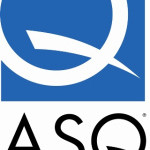- المجال: Quality management
- Number of terms: 21751
- Number of blossaries: 0
- Company Profile:
American Society for Quality (ASQ) is a global community of quality management professionals. Established in 1946 as the American Society for Quality Control (ASQC) in response to the need to sustain the many quality-improvement techniques used manufacturing during World War II, the organization ...
Used to test the null hypothesis that two populations have identical distribution functions against the alternative hypothesis that the two distribution functions differ only with respect to location (median), if at all. It does not require the assumption that the differences between the two samples are normally distributed. In many applications, it is used in place of the two sample t-test when the normality assumption is questionable. This test can also be applied when the observations in a sample of data are ranks, that is, ordinal data rather than direct measurements.
Industry:Quality management
Five Japanese terms beginning with “s” used to create a workplace suited for visual control and lean production. Seiri means to separate needed tools, parts and instructions from unneeded materials and to remove the unneeded ones. Seiton means to neatly arrange and identify parts and tools for ease of use. Seiso means to conduct a cleanup campaign. Seiketsu means to conduct seiri, seiton and seiso daily to maintain a workplace in perfect condition. Shitsuke means to form the habit of always following the first four S’s.
Industry:Quality management
A quality improvement or self-improvement study group composed of a small number of employees (10 or fewer) and their supervisor. Quality circles originated in Japan, where they are called quality control circles.
Industry:Quality management
An essential part of a quality improvement effort. Organization leaders must establish a vision, communicate that vision to those in the organization and provide the tools and knowledge necessary to accomplish the vision.
Industry:Quality management
The graphical representation of a variable’s tendency, over time, to increase, decrease or remain unchanged.
Industry:Quality management
A parabolic approximation of the quality loss that occurs when a quality characteristic deviates from its target value. The quality loss function is expressed in monetary units: the cost of deviating from the target increases quadratically the farther the quality characteristic moves from the target. The formula used to compute the quality loss function depends on the type of quality characteristic being used. The quality loss function was first introduced in this form by Genichi Taguchi.
Industry:Quality management
A statistical procedure for troubleshooting industrial processes and analyzing the results of experimental designs with factors at fixed levels. It provides a graphical display of data. Ellis R. Ott developed the procedure in 1967 because he observed that nonstatisticians had difficulty understanding analysis of variance. Analysis of means is easier for quality practitioners to use because it is an extension of the control chart. In 1973, Edward G. Schilling further extended the concept, enabling analysis of means to be used with non-normal distributions and attributes data in which the normal approximation to the binomial distribution does not apply. This is referred to as analysis of means for treatment effects.
Industry:Quality management
The value of percentage defective or of defects per hundred units in a lot.
Industry:Quality management
A formal agreement between an internal provider and an internal receiver (customer).
Industry:Quality management
A lean manufacturing tool that enables operators to observe a production process with an understanding of how assembly tasks are to be performed. It ensures the quality level is understood and serves as an excellent training aid, enabling replacement or temporary individuals to easily adapt and perform the assembly operation.
Industry:Quality management
